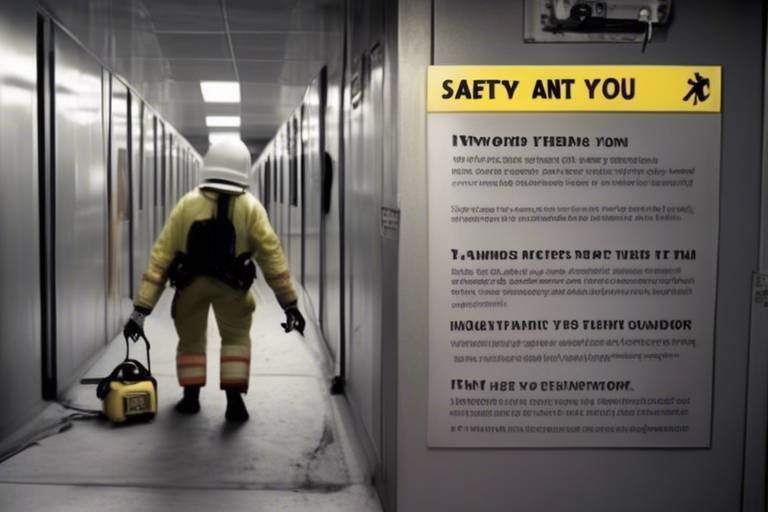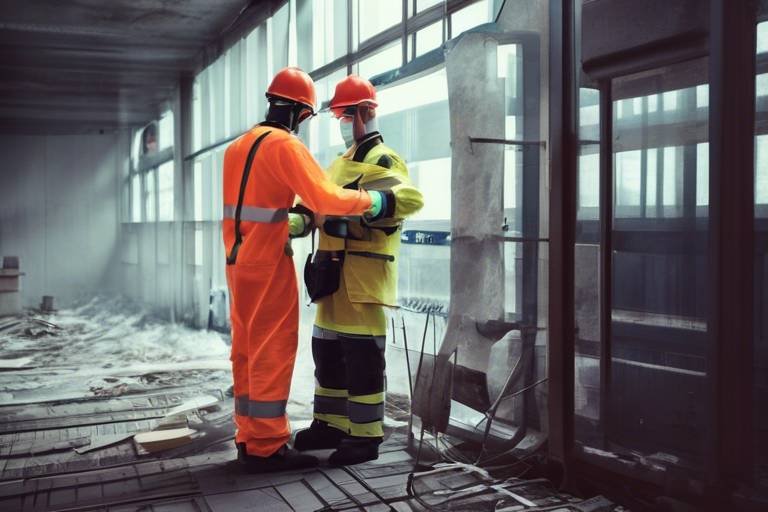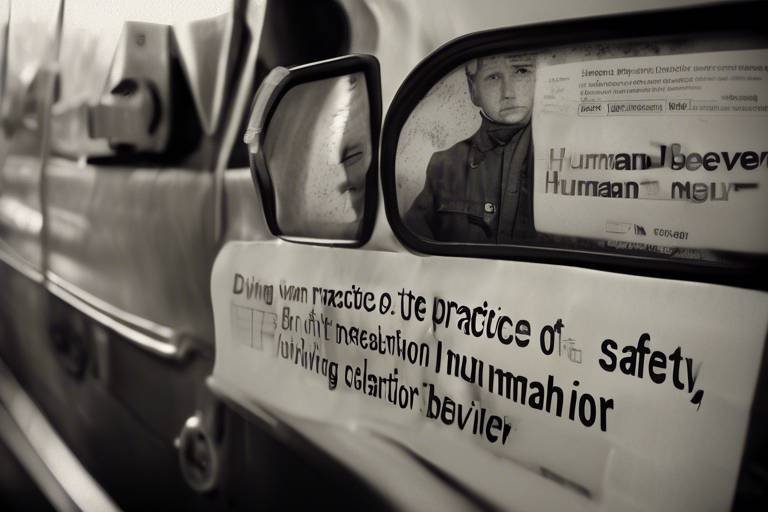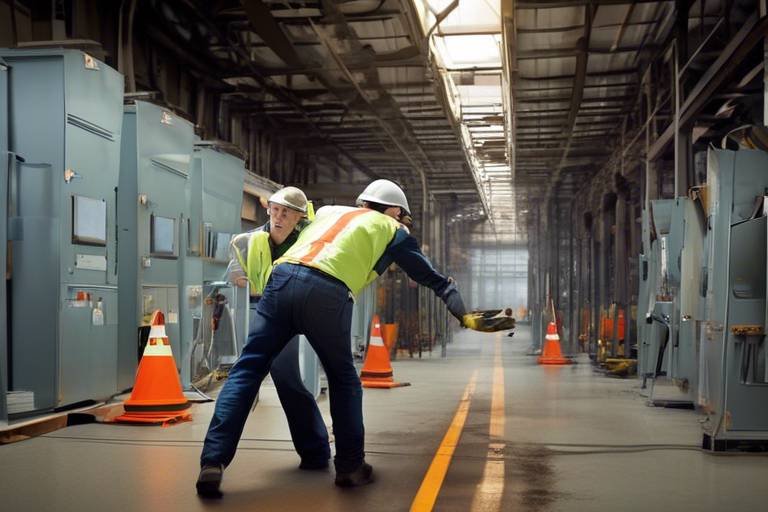Redefining Safety through the Lens of Human Behaviour
In today's fast-paced world, the concept of safety is evolving. It's no longer just about following rules or wearing protective gear; it's about understanding the human element that underpins every safety protocol. Imagine a construction site bustling with activity. The workers, equipped with helmets and harnesses, follow safety guidelines diligently. But what if I told you that their mindset and behaviors have a profound impact on how safe they actually are? This article explores the intersection of safety practices and human behavior, highlighting how understanding psychological factors can enhance safety protocols across various environments.
Safety is often perceived as a set of rigid rules, but in reality, it is a dynamic interplay between human behavior and environmental factors. When we dig deeper, we discover that our perceptions, attitudes, and even our emotions can significantly influence how we approach safety. For instance, if a worker feels invulnerable, they might take unnecessary risks, disregarding established safety procedures. Conversely, a culture that promotes safety awareness can lead to more cautious and compliant behaviors. This duality is what makes safety not just a set of practices, but a holistic approach that must consider the human psyche.
To truly redefine safety, we must first understand the psychology of safety. This involves examining the mental processes that influence safety behaviors. Think about it: how often do we see someone disregard safety regulations simply because they believe "it won't happen to me"? This mindset can be dangerous, leading to complacency and ultimately, accidents. By recognizing these psychological barriers, we can start to develop strategies that encourage safer behaviors. For instance, implementing regular training sessions that focus on the importance of safety can help shift attitudes and reinforce the idea that safety is a shared responsibility.
Furthermore, human error plays a significant role in many safety incidents. It's essential to delve into the factors that contribute to these mistakes. Often, errors stem from a lack of awareness or insufficient training. By emphasizing the importance of training and awareness, organizations can equip their employees with the tools they need to make informed decisions. This proactive approach not only minimizes mistakes but also fosters a culture of safety where individuals feel empowered to speak up about unsafe practices.
As we explore the nuances of safety, we must also consider the impact of cognitive biases on decision-making. These biases can cloud judgment and lead to unsafe behaviors. For example, confirmation bias can cause individuals to seek out information that supports their existing beliefs while ignoring evidence that contradicts them. This can be particularly dangerous in safety-critical environments where objective evaluation is crucial. On the other hand, overconfidence bias can lead individuals to overestimate their abilities, resulting in risky behavior. Understanding these biases is key to developing strategies that encourage more rational decision-making and ultimately, a safer environment.
To effectively change behaviors, safety training must focus not just on compliance, but on instilling a safety-first mindset. This means creating training programs that engage employees, encouraging them to think critically about their actions and the potential consequences. By fostering an environment where safety is a priority, organizations can cultivate a culture that values safety as a core principle rather than just a checklist item.
Leadership plays a pivotal role in shaping this safety culture. Leaders who model safe behaviors and prioritize safety in their policies set the tone for the entire organization. They can influence safety behaviors by leading by example, demonstrating that safety is not just a responsibility but a fundamental value. This creates a ripple effect, encouraging employees to adopt similar attitudes and behaviors.
Creating a safe-first environment is essential for fostering a culture of safety. This involves establishing open lines of communication where employees feel comfortable reporting unsafe practices without fear of retribution. When individuals know that their voices matter, they are more likely to contribute to safety discussions and share their insights, leading to continuous improvement in safety protocols.
Lastly, feedback mechanisms are crucial for enhancing safety. Organizations that actively seek and act on feedback can make significant strides in their safety practices. By regularly assessing safety protocols and making adjustments based on employee input, companies can create a culture of continuous improvement where safety is not just a goal but an ongoing commitment.
- What is the importance of understanding human behavior in safety practices? Understanding human behavior helps organizations tailor safety protocols to address psychological factors that influence compliance and risk-taking.
- How can cognitive biases affect safety decisions? Cognitive biases can lead individuals to make irrational decisions, increasing the likelihood of unsafe behaviors and accidents.
- What role does leadership play in promoting a safety culture? Leaders set the tone for safety culture by modeling safe behaviors and prioritizing safety in organizational policies.
- How can organizations encourage open communication about safety? By fostering an environment where employees feel safe to report unsafe practices and share feedback without fear of repercussions.

The Psychology of Safety
When we talk about safety, it's easy to think about rules, regulations, and protocols. But what if I told you that at the heart of every safety practice lies the intricate web of human psychology? Our perceptions, attitudes, and mental processes play a crucial role in how we approach safety in various environments. Understanding these psychological factors is not just an academic exercise; it's a vital step toward enhancing compliance with safety regulations.
Take a moment to consider this: Have you ever noticed how some people seem to follow safety guidelines to the letter, while others act as if they’re invincible? This discrepancy often boils down to individual perceptions of risk. Some individuals may underestimate the dangers associated with certain tasks, while others may overestimate them. This creates a spectrum of behaviors, from those who are overly cautious to those who are recklessly bold. It's this variation in human behavior that can lead to either safe practices or disastrous outcomes.
Moreover, our attitudes towards safety can be heavily influenced by our past experiences. For instance, if someone has previously encountered a safety incident, they may become more vigilant and compliant with safety measures. On the other hand, a person who has never faced any repercussions might develop a sense of invulnerability, leading them to dismiss safety protocols. This illustrates how the psychological lens through which we view safety can either bolster or undermine our efforts to maintain a secure environment.
In many cases, the social environment also plays a significant role in shaping our safety behaviors. When safety is prioritized within a workplace culture, employees are more likely to adopt safe practices. Conversely, if a company downplays the importance of safety, workers may feel less compelled to adhere to safety guidelines. This highlights the importance of fostering a positive safety culture, where safety is not just a checkbox on a list but a core value that everyone embraces.
To better understand the psychological factors at play, let’s consider a few key elements that influence safety behaviors:
- Risk Perception: How individuals assess the risks associated with their actions.
- Personal Experience: Past incidents that shape one's attitude towards safety.
- Social Influence: The impact of peers and organizational culture on safety compliance.
Recognizing these elements can help organizations tailor their safety protocols to address the psychological barriers that may lead to unsafe behaviors. For example, implementing regular safety training sessions can reinforce the importance of safety and provide employees with the tools they need to recognize and mitigate risks. By doing so, companies can create an environment where safety becomes second nature to everyone involved.
Ultimately, the psychology of safety is a complex but essential aspect that cannot be overlooked. By understanding the mental processes that influence safety behaviors, we can develop more effective safety protocols that resonate with individuals on a personal level. This approach not only enhances compliance but also fosters a culture of safety that can lead to significant reductions in accidents and injuries.

Human Error and Safety
When we talk about safety, we often think about protocols, equipment, and regulations. However, a significant factor that can make or break these systems is human error. It's fascinating to realize that no matter how advanced our safety measures may be, the human element introduces an unpredictable variable. Have you ever wondered why accidents happen even when all the precautions are in place? This is where understanding human behavior becomes crucial. By exploring the psychology behind human error, we can develop strategies that not only minimize mistakes but also enhance overall safety.
Human error can be categorized into three main types: slips, lapses, and mistakes. Each type presents unique challenges and requires different approaches to address. For instance, slips are often unintentional actions that occur during routine tasks, like forgetting to wear protective gear. Lapses, on the other hand, involve memory failures, such as overlooking a step in a safety procedure. Finally, mistakes are the result of poor decision-making, often influenced by incomplete information or cognitive biases. Understanding these categories is essential for creating effective training programs aimed at reducing human error.
To illustrate the impact of human error on safety, let’s take a look at a simple table that outlines common scenarios and their corresponding errors:
| Scenario | Type of Error | Potential Consequences |
|---|---|---|
| Operating machinery without proper checks | Slip | Injury or equipment damage |
| Forgetting to follow safety protocols | Lapse | Increased risk of accidents |
| Ignoring warning signs due to overconfidence | Mistake | Severe accidents or fatalities |
It's evident from the table that the consequences of human error can be dire. However, the good news is that we can implement strategies to mitigate these risks. Training programs that focus on awareness, communication, and teamwork can significantly reduce the likelihood of errors. For example, simulating real-life scenarios in training can prepare employees to react appropriately under pressure, thus minimizing the chances of lapses or slips.
Another effective approach is to foster a culture of open communication. When employees feel safe to report errors or near misses without fear of punishment, organizations can learn from these incidents and implement changes to prevent future occurrences. This proactive stance not only improves safety but also builds trust among team members, leading to a more cohesive work environment.
In conclusion, while human error is an inevitable part of any safety system, understanding its roots and implementing targeted strategies can significantly enhance safety outcomes. By focusing on education, communication, and a culture of continuous improvement, we can redefine safety not just as a set of rules, but as a collective responsibility that every individual shares.
- What are the main types of human error in safety? The main types include slips, lapses, and mistakes, each requiring different strategies for mitigation.
- How can organizations reduce human error? By implementing effective training, fostering open communication, and creating a culture of safety, organizations can significantly reduce human error.
- Why is it important to report near misses? Reporting near misses helps organizations learn from potential errors and improve safety protocols, ultimately preventing accidents.

Cognitive Biases in Decision Making
When we talk about safety, we often think about protocols, checklists, and regulations. But what about the human brain? It's fascinating how our mental processes can influence our decisions, especially in high-stakes environments. Cognitive biases are like invisible glasses through which we view the world; they can distort our perceptions and lead us to make unsafe choices. Understanding these biases is crucial for improving safety and ensuring that our decisions are not just based on instinct but on sound reasoning.
Imagine you're driving a car. You might think, "I’ve driven this route a hundred times; I know it by heart!" This is a classic case of overconfidence bias. You feel invincible, and that can lead to taking unnecessary risks, like speeding or ignoring traffic signals. In safety-critical situations, this bias can have dire consequences. Recognizing that we all have limits can help us adopt a more cautious approach. By acknowledging our cognitive biases, we can create strategies to counteract them.
Another common bias is confirmation bias, where individuals tend to favor information that confirms their existing beliefs while disregarding contradictory evidence. For instance, if a worker believes that safety gear is unnecessary because they’ve never had an accident, they may ignore safety training or guidelines that suggest otherwise. This bias can be particularly dangerous in workplaces where safety regulations are paramount. To combat this, it’s essential to foster an environment that encourages objective evaluation of safety practices rather than relying solely on personal experiences.
To illustrate the impact of cognitive biases on decision-making, consider the following table that outlines some common biases and their effects on safety:
| Cognitive Bias | Description | Impact on Safety |
|---|---|---|
| Overconfidence Bias | The tendency to overestimate one's abilities. | Leads to risky behavior and neglect of safety measures. |
| Confirmation Bias | Favoring information that confirms existing beliefs. | Results in ignoring critical safety data and guidelines. |
| Anchoring Bias | Relying too heavily on the first piece of information encountered. | Can lead to poor decision-making based on outdated practices. |
Addressing these biases requires a concerted effort from all levels of an organization. Training programs should not only focus on technical skills but also on awareness of cognitive biases. By teaching employees about these mental shortcuts, organizations can empower them to make safer choices. Encouraging open discussions about past mistakes and biases can help create a culture of safety where everyone feels responsible for their actions.
In conclusion, cognitive biases can significantly impact decision-making, especially in safety-critical situations. By understanding and addressing these biases, organizations can enhance their safety protocols and cultivate a culture that prioritizes well-being. After all, safety is not just about following rules; it's about making informed decisions that protect everyone involved.
- What are cognitive biases? Cognitive biases are systematic patterns of deviation from norm or rationality in judgment, affecting decisions and judgments.
- How do cognitive biases affect safety? They can lead individuals to make unsafe decisions by distorting their perception of risks and benefits.
- Can training help reduce cognitive biases? Yes, training that focuses on awareness and understanding of biases can help individuals make better, safer choices.

Confirmation Bias
is a psychological phenomenon where individuals tend to search for, interpret, and remember information in a way that confirms their pre-existing beliefs or hypotheses. This bias can significantly impact safety decision-making, leading individuals to overlook critical information that contradicts their views. Imagine a safety officer who believes that a particular machine is safe to operate without additional safeguards. If this officer encounters data suggesting potential hazards, they might dismiss it, focusing instead on information that supports their initial belief. This can create a dangerous environment where risks are underestimated, and safety protocols are inadequately followed.
Understanding confirmation bias is essential for organizations aiming to enhance their safety practices. By recognizing that our perceptions can cloud our judgment, we can take proactive steps to mitigate its effects. For example, organizations can implement structured decision-making processes that require a thorough review of all relevant data, regardless of whether it supports or contradicts existing beliefs. This approach not only encourages a more comprehensive evaluation of safety risks but also fosters a culture of open-mindedness and critical thinking.
To illustrate how confirmation bias can manifest in safety contexts, consider the following scenarios:
- A construction manager who believes that their team is adhering to safety protocols might ignore reports of unsafe practices, leading to potential accidents.
- An employee who has never experienced an incident may disregard safety warnings, believing that their experience is sufficient to avoid risks.
- A maintenance technician who has always used a particular tool without incident may resist adopting new safety equipment, thinking it unnecessary.
Addressing confirmation bias requires not only awareness but also the implementation of strategies aimed at fostering a more objective evaluation of safety practices. Regular training sessions that emphasize the importance of critical thinking and encourage employees to challenge their assumptions can be beneficial. Additionally, creating an environment where employees feel safe to voice concerns and report unsafe practices without fear of retribution is crucial. When teams are encouraged to question the status quo and seek out diverse perspectives, they can collectively work toward a safer workplace.
In summary, confirmation bias is a subtle yet powerful force that can undermine safety initiatives. By acknowledging its existence and actively working to counteract its effects, organizations can create a more robust safety culture that prioritizes objective evaluation and continuous improvement.
- What is confirmation bias? Confirmation bias is the tendency to favor information that confirms one’s existing beliefs while disregarding contradictory evidence.
- How does confirmation bias affect safety? It can lead individuals to overlook risks and dismiss safety warnings, potentially resulting in unsafe practices and accidents.
- What can organizations do to combat confirmation bias? Organizations can implement structured decision-making processes, promote critical thinking in training, and foster an open communication environment.

Overconfidence Bias
Overconfidence bias is a psychological phenomenon where individuals overestimate their abilities, knowledge, or control over situations, often leading them to take unnecessary risks. Imagine you're driving a car and thinking, "I’ve been driving for years; I can handle anything!" This mindset can lead to reckless behaviors such as speeding or texting while driving, which significantly increase the chances of accidents. The irony is that while confidence is generally a positive trait, when it crosses the line into overconfidence, it can become a perilous pitfall, especially in safety-critical environments.
Research has shown that overconfident individuals tend to ignore safety protocols, believing they are invulnerable to accidents. This belief can manifest in various ways, such as underestimating the time required to complete tasks safely or dismissing the importance of safety training. For instance, a construction worker might feel that wearing a hard hat is unnecessary because they have never experienced an accident before. However, this lack of precaution could lead to dire consequences, not just for themselves but also for their colleagues.
To combat overconfidence bias, organizations can implement several strategies aimed at fostering a culture of humility and awareness regarding safety. Here are a few effective methods:
- Encourage Self-Reflection: Regular training sessions can help employees reflect on their past experiences, fostering an understanding of their limitations.
- Promote Open Discussions: Creating an environment where team members can discuss their mistakes without fear of retribution encourages learning and growth.
- Utilize Data and Feedback: Providing employees with data on incidents and near-misses can help them realize that overconfidence can lead to serious consequences.
In essence, addressing overconfidence bias is not just about changing individual mindsets; it's about creating a culture that values safety above all else. By promoting awareness and encouraging a more realistic assessment of risks, organizations can significantly reduce the likelihood of accidents caused by overconfidence. Remember, safety isn't just a personal responsibility; it's a collective commitment that requires everyone to be on the same page.
By understanding the nuances of overconfidence bias and its implications on safety behaviors, organizations can take proactive steps to mitigate risks. This approach not only protects employees but also enhances overall workplace safety culture, ensuring that everyone goes home safe at the end of the day.
- What is overconfidence bias? Overconfidence bias is the tendency to overestimate one’s abilities or knowledge, which can lead to risky behaviors and poor decision-making.
- How does overconfidence bias affect safety? It can lead individuals to ignore safety protocols and take unnecessary risks, increasing the likelihood of accidents.
- What can organizations do to combat overconfidence bias? Organizations can encourage self-reflection, promote open discussions, and utilize data and feedback to raise awareness about the dangers of overconfidence.

Training for Behavioral Change
When it comes to enhancing safety in the workplace, the key often lies in effective . It's not just about teaching employees the rules; it's about instilling a deep-seated commitment to safety in their daily actions. Think of it as planting a seed that needs nurturing to grow into a sturdy tree—one that stands tall against the winds of negligence and oversight. So, how do we cultivate this culture of safety? It starts with understanding that behavioral change is a journey, not a destination.
First and foremost, training programs should be designed to be engaging and relatable. Gone are the days of dry, monotonous lectures that put everyone to sleep. Instead, we need to incorporate interactive elements that resonate with employees on a personal level. This could include role-playing scenarios where workers can practice safety protocols in real-time, or even gamified training modules that reward safe behaviors. When employees are actively involved in their learning, they are more likely to internalize the safety practices being taught.
Moreover, it's essential to address the psychological aspects of safety. Training should not only focus on the 'how' but also the 'why' behind safety measures. For instance, explaining the impact of a safety breach can evoke an emotional response that reinforces the importance of compliance. Consider using case studies or testimonials from individuals who have experienced safety incidents firsthand. This approach can be incredibly powerful, as it transforms abstract concepts into tangible realities, making the need for safety more urgent and relatable.
Another effective strategy is to implement peer-to-peer training. Employees often feel more comfortable learning from their colleagues than from higher-ups. By creating a culture where team members can share their experiences and insights, we foster an environment of mutual support and accountability. This not only enhances learning but also strengthens team dynamics, as everyone works together towards a common goal: safety.
Finally, it's crucial to recognize that training for behavioral change is not a one-time event. It requires continuous reinforcement and adaptation. Regular refresher courses, ongoing assessments, and feedback loops are vital to ensure that safety remains a priority. Remember, just like fitness, safety is a practice that needs to be maintained. Establishing a system for ongoing training can help keep safety at the forefront of everyone’s mind.
In conclusion, the path to a safer workplace is paved with intentional, engaging, and ongoing training that focuses on changing behaviors. By understanding the psychological underpinnings of safety, utilizing interactive training methods, and fostering a supportive culture, organizations can significantly enhance their safety protocols. It’s about creating a mindset where safety becomes second nature—a fundamental part of every employee's daily routine.
- What is the importance of training for behavioral change in safety?
Training for behavioral change is crucial as it helps employees internalize safety practices, leading to a more proactive approach to safety in the workplace.
- How can training be made more engaging?
Incorporating interactive elements such as role-playing, gamification, and real-life case studies can make training more engaging and relatable.
- Is safety training a one-time event?
No, safety training should be an ongoing process with regular refreshers and feedback to ensure continuous improvement and adherence to safety protocols.

The Role of Leadership in Safety Culture
Leadership is not just about making decisions; it's about setting the tone for the entire organization. When it comes to safety culture, leaders play a pivotal role in shaping attitudes and behaviors that can either enhance or undermine safety practices. Think of leaders as the captains of a ship; their direction and vision guide the crew through calm and stormy waters alike. If the captain is vigilant about safety, the crew is likely to follow suit, creating a ripple effect that permeates the organization.
One of the most significant ways leaders can influence safety culture is through their own behavior. When leaders prioritize safety, it sends a clear message that safety is a core value. This can be demonstrated through various actions, such as:
- Regularly participating in safety drills and training sessions
- Openly discussing safety concerns in meetings
- Recognizing and rewarding safe behaviors among employees
By modeling these behaviors, leaders can foster an environment where safety is seen not just as a checkbox but as an integral part of daily operations. It’s crucial for leaders to communicate the importance of safety in a way that resonates with employees. This can involve sharing personal stories about safety incidents or discussing the impact of unsafe practices on both the workforce and the organization as a whole.
Moreover, establishing a safety-first environment is essential for cultivating a robust safety culture. This means creating a space where employees feel empowered to voice their concerns without fear of retribution. When workers know that their input is valued and taken seriously, they are more likely to report unsafe practices and suggest improvements. An effective way to encourage this open communication is through regular safety meetings and feedback sessions, where team members can share their thoughts and experiences.
In addition to fostering open dialogue, leaders must also be proactive in implementing safety policies that reflect the organization’s commitment to safety. This includes developing clear guidelines and procedures that everyone understands and adheres to. It’s not enough to have these policies on paper; leaders must ensure that they are actively enforced and regularly reviewed for effectiveness. This commitment to continuous improvement reinforces the idea that safety is an ongoing priority rather than a one-time initiative.
Furthermore, leaders can enhance safety culture by investing in training and development programs focused on safety awareness and skills. These programs should not only cover the technical aspects of safety but also address the psychological factors that influence behavior. For example, training sessions can incorporate discussions about cognitive biases and how they affect decision-making in safety scenarios. By equipping employees with the knowledge and tools they need to recognize and mitigate risks, leaders can create a more informed and vigilant workforce.
Ultimately, the role of leadership in safety culture cannot be overstated. It requires a commitment to modeling safe behaviors, fostering open communication, enforcing policies, and investing in training. When leaders take these steps, they not only enhance safety practices but also build a culture where safety is valued and prioritized. This cultural shift can lead to a significant reduction in incidents and injuries, creating a safer and more productive workplace for everyone.
- What is the role of leadership in safety culture?
Leadership sets the tone for safety practices within an organization by modeling safe behavior, enforcing policies, and fostering open communication. - How can leaders encourage a safety-first environment?
Leaders can create a safety-first environment by actively participating in safety initiatives, recognizing safe behaviors, and encouraging employees to voice their concerns. - Why is open communication important in safety culture?
Open communication allows employees to report unsafe practices and suggest improvements, leading to a more vigilant and informed workforce.

Creating a Safety-First Environment
Creating a Safety-First Environment is not just about implementing rules; it's about cultivating a culture where safety is woven into the very fabric of daily operations. Imagine walking into a workplace where every employee feels empowered to speak up about unsafe practices without fear of repercussions. This is the kind of environment that not only promotes compliance but also fosters a sense of community and trust among team members. To achieve this, organizations must focus on several key elements.
First and foremost, leadership commitment is essential. When leaders prioritize safety, it sends a clear message that safety is everyone's responsibility. Leaders should actively participate in safety training sessions, demonstrate safe behaviors themselves, and consistently communicate the importance of safety in all aspects of the business. This visible commitment can significantly influence employees' attitudes towards safety.
Another critical aspect is open communication. Encouraging employees to voice their concerns and suggestions regarding safety can create a more engaged workforce. This could be facilitated through regular safety meetings, anonymous feedback systems, or suggestion boxes. When employees see that their input is valued and acted upon, they are more likely to take ownership of safety practices.
Furthermore, organizations should implement a robust reporting system for unsafe conditions or near misses. This system should not only allow employees to report hazards easily but also ensure that they feel safe doing so. For instance, a non-punitive approach to reporting can encourage more individuals to come forward. The more data collected on unsafe practices, the better the organization can understand and mitigate risks.
Additionally, training programs should be tailored to address the specific needs of the workforce. For example, using real-life scenarios that employees might face can make safety training more relatable and impactful. Incorporating interactive elements such as role-playing or simulations can also enhance engagement and retention of safety protocols.
Lastly, it’s crucial to celebrate safety milestones. Recognizing teams or individuals who excel in safety practices not only boosts morale but also reinforces the importance of safety within the organization. This can be done through awards, shout-outs in meetings, or even simple thank-you notes. Such recognition fosters a positive attitude toward safety and encourages continuous improvement.
In summary, creating a safety-first environment is about more than just rules and regulations; it's about building a culture where safety is prioritized and everyone feels responsible. By focusing on leadership commitment, open communication, effective reporting systems, tailored training, and recognition, organizations can cultivate a workplace where safety flourishes.
- What are the key elements of a safety-first environment? A safety-first environment includes leadership commitment, open communication, effective reporting systems, tailored training, and recognition of safety efforts.
- How can leaders influence safety culture? Leaders can influence safety culture by actively participating in safety initiatives, demonstrating safe behaviors, and consistently communicating the importance of safety.
- Why is open communication important in safety practices? Open communication encourages employees to voice their concerns and suggestions, making them feel valued and more likely to take ownership of safety practices.
- What role does training play in creating a safety-first environment? Tailored training programs that address specific needs and incorporate interactive elements help employees understand and retain safety protocols effectively.

Feedback and Continuous Improvement
In the realm of safety, feedback is not just a tool—it's a lifeline. Imagine a ship navigating through turbulent waters; without constant updates on the weather and sea conditions, it risks capsizing. Similarly, organizations must continuously gather feedback from their employees and stakeholders to ensure that safety protocols remain effective and relevant. This process of feedback and continuous improvement is vital for fostering a culture where safety is prioritized and ingrained in everyday practices.
But why is feedback so crucial? For starters, it provides insights into the effectiveness of existing safety measures. When employees feel empowered to share their thoughts and experiences, they contribute to a broader understanding of potential hazards and gaps in safety protocols. This open dialogue can lead to significant improvements, as organizations can adapt their strategies based on real-world experiences rather than theoretical models.
Moreover, feedback mechanisms encourage a sense of ownership among employees. When team members know their voices matter, they are more likely to engage with safety practices actively. This engagement can take many forms, from reporting near-misses to suggesting new safety initiatives. In turn, this creates a feedback loop that not only enhances safety but also boosts morale and team cohesion.
To effectively implement feedback systems, organizations can consider various methods:
- Surveys and Questionnaires: Regularly distribute surveys to gauge employee perceptions of safety protocols and identify areas for improvement.
- Safety Committees: Establish committees that include members from various departments to discuss safety issues and propose solutions.
- Incident Reporting Systems: Create an anonymous reporting system where employees can report unsafe conditions without fear of retribution.
It's important to remember that feedback should not be a one-way street. Organizations must actively respond to the feedback received. This means not only acknowledging the input but also taking actionable steps to implement changes. When employees see their suggestions being taken seriously, it reinforces the belief that safety is a shared responsibility.
Continuous improvement in safety practices also involves regular training and refreshers. As new challenges emerge, whether from changes in technology, regulations, or workplace dynamics, organizations must adapt their safety protocols accordingly. This adaptability can be achieved through ongoing education and training sessions, where employees are updated on the latest safety practices and encouraged to share their insights.
In conclusion, feedback and continuous improvement are essential components of a robust safety culture. By fostering an environment where employees feel comfortable sharing their thoughts and experiences, organizations can create a dynamic safety framework that evolves with the needs of the workforce. Remember, safety is not a destination; it's a journey that requires constant vigilance and a commitment to improvement.
- What is the importance of feedback in safety practices? Feedback is crucial as it helps identify gaps in safety protocols and encourages employee engagement in safety initiatives.
- How can organizations implement effective feedback mechanisms? Organizations can use surveys, safety committees, and incident reporting systems to gather feedback from employees.
- Why is continuous improvement essential in safety culture? Continuous improvement ensures that safety practices remain relevant and effective in addressing new challenges and risks.
- How can feedback enhance employee morale? When employees see their input valued and acted upon, it fosters a sense of ownership and commitment to safety.
Frequently Asked Questions
- What is the connection between human behavior and safety practices?
Human behavior plays a crucial role in safety practices. By understanding the psychological factors that influence how individuals perceive risks and adhere to safety regulations, organizations can develop more effective safety protocols. This means that enhancing safety isn't just about rules and regulations; it's about changing mindsets and behaviors.
- How does human error impact safety incidents?
Human error is often a significant factor in safety incidents. Mistakes can arise from various sources, including lack of training, fatigue, or even cognitive biases. By focusing on training and awareness, organizations can minimize the likelihood of errors, ultimately leading to safer work environments.
- What are cognitive biases, and how do they affect safety decision-making?
Cognitive biases are systematic patterns of deviation from norm or rationality in judgment. They can lead individuals to make unsafe decisions without even realizing it. For instance, confirmation bias may cause someone to disregard evidence that contradicts their beliefs about safety, while overconfidence bias can lead to risky behaviors. Recognizing these biases is essential for improving safety outcomes.
- What strategies can be used to change safety behaviors?
To instill a safety-first mindset, effective training should focus on behavioral change. This can include interactive workshops, role-playing scenarios, and regular safety drills. The goal is to create an engaging learning environment where employees feel empowered to prioritize safety in their daily routines.
- How can leadership influence safety culture?
Leadership is pivotal in shaping a strong safety culture. Leaders can set the tone by modeling safe behaviors, implementing clear safety policies, and encouraging open communication about safety concerns. When leaders prioritize safety, it fosters a culture where everyone feels responsible for maintaining a safe environment.
- What is a safety-first environment, and why is it important?
A safety-first environment is one where safety is the top priority, and employees are encouraged to report unsafe practices without fear of repercussions. This type of environment promotes transparency and accountability, making it easier to identify and address potential hazards before they lead to incidents.
- Why is feedback important for safety improvement?
Feedback is essential for continuous improvement in safety practices. By gathering input from employees about safety protocols and incidents, organizations can identify areas for enhancement. Implementing changes based on feedback ensures that safety measures evolve and adapt to the needs of the workforce.



















